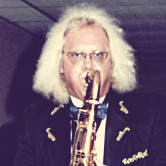Too many times the technician uses the same materials and techniques that his grandfather used! There are better materials and techniques available today which do a much better job of repairing your saxophone. I’ll try to outline a few of the “out of the ordinary” things that we use in our overhauls and repairs, and look forward to hearing from any of you who have thought outside the box about better ways to fix your horn.
MAGNETIC DENT REMOVAL
This has to be the slickest thing I’ve seen in thirty plus years in the repair business: very powerful rare earth magnets manipulate steel balls placed inside the horn and quickly smooth the dents out. This system works remarkably well on all large tubing sections, not so well on necks because the smaller balls that would be required lack sufficient mass to move the metal. This system is a terrific time saver, and often does a better job than conventional dent removal. A little practice is necessary to master the technique, but once you get into the swing of things no dent on your horn is safe! Of course, you can’t get around posts and tone holes, but for dents in the bow and on the body tube this method has become the technique of choice for many technicians. The system will do at least eighty percent of the dents you are likely to find on a horn, and has the tremendous advantage of generally not requiring disassembly of the bow in order to reach the body tube. All that is required is that you roll the proper sized ball up the tube and locate it with the magnet. The tools required are not significantly more expensive than conventional dent removing balls and rods, and I believe that the proper technique is much easier to learn. To do a full job, you will still need some conventional apparatus, but this is a great way to get the big ugly dents out quickly. Care has to be used, because the magnets used are very powerful, and serious injury can result from careless use.
CORK SUBSTITUTES
I almost never use regular cork anywhere on a saxophone. Cork tends to compress; it becomes brittle with age, and tends to break. There are a number of alternative products that work much better, and I can’t for the life of me understand why anybody is still using cork for key feet, silencers, and linkages. A readily available material is Automotive Gasket Material, which is available in a variety of forms at any auto supply store. I like the rubberized sheets, which can be had, in several different thicknesses. The glue very nicely, and don’t compress. They don’t sand particularly well, but if you work carefully you can get nice results. I’ve also become a big fan of Synthetic Cork from Kraus Musical Products. Now this is amazing stuff that can be had in many different thicknesses and in different degrees of firmness. It sands, it doesn’t compress, and it takes the glue nicely. It also absorbs impact very well, and helps reduce key flutter. On the subject of reducing key flutter, Sorbothane is absolutely without equal. It is quite difficult to work with, and is rather expensive, but nothing stops the lower stack of a tenor from bouncing like it! From time to time, I also use Electrical Shrink Tubing to cover linkages. You can always get a perfect fit, and no adhesive is necessary. It doesn’t compress, and is impervious to oils. Lately, I’ve been using Gummy Cork from my friends at MusicMedic.com. Now this may be the ultimate solution! This material is natural cork filled with some sort of synthetic particles. It cuts, sands, glues, and even looks like natural cork. It has great impact absorbing qualities. It is also available in a large number of thicknesses. Better yet, the price is right! You’ve really got to try this amazing product. This is the best thing that I’ve found. It also make a fine neck cork that won’t compress. Don’t forget that the sliding mechanism surfaces and key cradles should always be lined with Teflon. You can buy sheets in a sorted thickness from J.L. Smith & Co., and their product has an etched back, which holds glue nicely. Don’t waste your time with Teflon, which has an adhesive back: the adhesive is not strong enough. The sheets of Teflon are rather thin, and you can laminate it to Gummy Cork to get it to the desired thickness. Some technicians tell me that they have been using Ultra Suede on key linkages. I’ve tried this stuff, and since it can’t be adjusted easily, I don’t think it’s for me. I have used Pigskin. And find that you can adjust it by heating and compressing it, but I believe that there are simply better options available.
ADHESIVES
I gave up my contact cement habit a couple of years ago. Now, I use Permatex Brand Automotive Weatherstrip Adhesive for gluing on corks and felts. This glue is available at any auto parts store and works very well indeed. I’ve also used E6000 glue with good results, but much prefer the weatherstrip adhesive. For pad installation, I have recently become a convert to Burn In Glue from the Ed Myers Company. This is simply shellac in an alcohol suspension (the alcohol evaporates when heated), and it allows me to “paint” an even coat all over the cup using a small brush. I have also tried some of the other adhesives available to the repair trade, such as George’s Hot Melt, French cement, and yes, hot glue. None of them worked satisfactorily, particularly the hot glue. Nothing, nothing, nothing holds as well as shellac. I used stick shellac exclusively for years, but the Burn In Glue gives me the same holding power and a much better means of application.
HEAT SOURCES
I use a Heat Gun by Milwaukee Tool for padding work. It’s next to impossible to burn the lacquer using one of these. It’s also adjustable for heat intensity, which gives me options. I also have a Propane Burner from Ferree Tool mounted on my bench. I installed a holder for the propane bottle under the bench using a fire extinguisher holder, and added a long hose, which enables me to take the heat to the work, rather than taking the work to the heat.
PADS
I often use Schmidt Synthetic Pads for palm keys and G# keys. They give very long life, don’t stick, and can be fitted with any resonator, which uses a through rivet. The installation can be tricky, requiring perfectly level tone holes and absolute key alignment. On the vast majority of my overhauls, I use the Prestini PS220 pad. This pad uses goatskin leather, which is extremely durable; extra firm felt, a chip board back, and a layer of brass foil between the leather and felt. These pads are more difficult to work with, but the results are spectacular. They give the horn an incredibly precise feel. I’ve also used them on Buescher saxophones, utilizing the old snap in pad backs glued to the back of pads, which have been punched to accept the snap nipple. For soprano sax palm keys, and all saxophone octave keys, I use cork clarinet pads. They last much longer.
I hope these ideas help encourage you to “think outside the box” and try different techniques. Let me know your questions, and may your leak light never dim!


